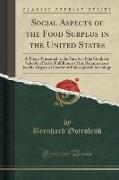- Start
- Social Aspects of the Food Surplus in the United States
Social Aspects of the Food Surplus in the United States
Angebote / Angebote:
Excerpt from Social Aspects of the Food Surplus in the United States: A Thesis Presented to the Faculty of the Graduate School in Partial Fulfillment of the Requirements for the Degree of Doctor of Philosophy in Sociology
With few exceptions, such as sugar and coffee, the United States has been substantially self-sustaining in all important food stuffs. There has been a surplus for exportation. This became more apparent during the war when the country was asked not only to produce its maximum, but to conserve in the consumption of the more important food stuffs such as meat, wheat, sugar and fats to enable the surplus to be large enough to be a factor in feeding the American allies. The war, in a sense, proved a test of American production and consumption. If during a period of such stress, when all stimuli of patriotism and self interest demanded every effort for increased production and decreased consumption, both or either one of these objectives were reached, it would be safe to argue that production, or consumption of food stuffs or both are elastic. However, if under the stress of such direct stimuli as were applied during that period, production failed to increase materially and consumption failed to fall off, if under the prodding of an admittedly efficient department of agriculture to stimulate production, and a food administration backed by popular opinion in its meatless, wheatless and sugarless programs, neither production showed an appreciable gain nor consumption showed an appreciable falling off, the latter in fact, showing a steady gain, it would augur that neither production nor consumption are elastic, that neither one of them can be altered to any large extent except by a careful program extending over a period of several years.
It will be the object of the first chapter to examine agricultural production over a period of years and note its trend in general with a particular view of the reaction of production during the war period. We will first examine some of the primary foods, (e. g. foods that are grown for direct consumption such as wheat) and then the more important secondary foods, (e. g. foods that require primary foods for their production such as all meats, milk, etc.) after that a summary survey will be taken.
About the Publisher
Forgotten Books publishes hundreds of thousands of rare and classic books. Find more at www.forgottenbooks.com
This book is a reproduction of an important historical work. Forgotten Books uses state-of-the-art technology to digitally reconstruct the work, preserving the original format whilst repairing imperfections present in the aged copy. In rare cases, an imperfection in the original, such as a blemish or missing page, may be replicated in our edition. We do, however, repair the vast majority of imperfections successfully, any imperfections that remain are intentionally left to preserve the state of such historical works.
Folgt in ca. 5 Arbeitstagen
